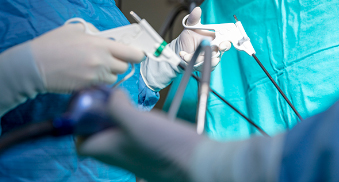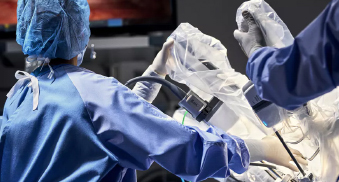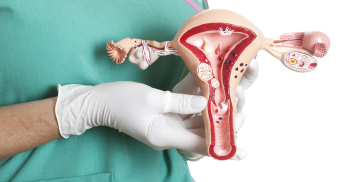PROCEDURE
Commitment to women’s well-being
She also has appointments to Macquarie University Hospital and Sydney Adventist Hospital.

Laparoscopy
Laparoscopic (keyhole) surgery is a minimally invasive surgery using 0.5-1cm cuts to place special telescope and various instruments to treat many gynaecology conditions such as Fibroids, Endometriosis, Ovarian cysts and Pelvic floor prolapse. High definition camera allows surgeons to visualise affected areas far better than conventional open surgery. Specially designed instruments enable the surgeon to perform all the delicate manoeuvres to remove diseased tissue precisely, have a meticulous control of bleeding, and even carry out fine tissue suturing. Laparoscopy is most commonly used to treat, pelvic pain, endometriosis, ovarian cysts, fibroid uterus and pelvic prolapse.
Overall benefits are:
- Reduced pain
- Less scarring
- Shorter hospital stay
- Rapid recovery and return to normal activity

Da Vinci Robot surgery
With the Da Vinci Surgical System, surgeons operate through just few small incisions. The Da Vinci System features a magnified 3D high-definition vision system and tiny wristed instruments that bend and rotate far greater than the human hand. As a result, Da Vinci enables surgeon to operate with enhanced vision, precision and control.
https://www.davincisurgery.com/da-vinci-gynecology/
Da Vinci can be used for hysterectomy , endometriosis, pelvic floor surgery and ovarian cysts.

Hysteroscopy
Hysteroscopy is a day procedure used to examine inside the uterus for various conditions most commonly abnormal bleeding and heavy menstrual periods. It is also used to carry out procedures ( Operative Hystereocopy ) for removal of polyps, fibroids , septum, adhesions and to treat heavy and/or abnormal bleeding.

Vaginal procedures, vagina wall repairs and/or vaginal hysterectomy
- anterior/bladder wall repair, also known as an anterior colporrhaphy is a surgical procedure to repair or reinforce the fascial support layer between bladder and vagina. It is commonly combined with other surgery such as vaginal hysterectomy, posterior vaginal wall repair or incontinence surgery.
- posterior/rectocele repair, also known as a posterior colporrhaphy, is a surgical procedure to repair or reinforce the fascial support layer between the rectum and the vagina. A perineorrhaphy is the term used for the operation that repairs the perineal body. The perineal body (the supporting tissue between vaginal and anal openings) also helps to support the back wall of the vagina. The perineum is the area that is often damaged when tears or episiotomies occur during childbirth. This area may need to be repaired along with the back wall of the vagina to give perineal support and in some cases reduce the vaginal opening.
What to expect after vaginal repair, including vaginal hysterectomy
- Immediately after your surgery, you may have a catheter (a tube) that drains urine from the bladder into a bag, and a pack in the vagina to prevent bleeding. Your doctor will specify how long these will need to stay in place, usually between 8 to 24 hours.
- After a vaginal repair you may notice that at first your urine flow is slowed and it takes longer than normal to empty your bladder. About 5 to 10% of women have difficulty emptying their bladder fully after surgery; a catheter may then be needed until swelling settles and the bladder returns to its normal function (usually after 1-2 weeks).
- Constipation is a common problem following surgery. Before and after your surgical procedure eat plenty of fruit and fiber and drink plenty of fluids to keep your stool soft. Following surgery stool softeners (laxatives) are often prescribed to help prevent constipation. Take these on a regular basis when you first go home. It is important to avoid excessive straining to pass a bowel motion as this can put pressure onto the stitches in the vagina. Some women experience burning or shooting pains in the rectum after surgery. This usually settles within a few days after surgery.
- It is normal to have some bleeding followed by a creamy white discharge that may last for up to 6 weeks as stitches in the vagina dissolve. At first the blood loss may be bright red; later this usually changes to a darker reddish brown. The amount of bleeding can vary from day to day. If you experience heavy fresh red bleeding or clots requiring frequent pad changes, contact your doctor. Use pads, not tampons, for the first 6 weeks after surgery.
- In the early post-operative period, you should avoid situations where excessive pressure is placed on the repair, i.e. lifting, straining, vigorous exercise, coughing and constipation. Maximal strength and healing around the repair occurs at 3 months and care with heavy lifting (>10kg/25lbs) needs to be taken until this time.

Colpsocopy
A colposcopy is a procedure used to look closely at the cervix, vagina and vulva to help locate changed or abnormal cells and see what they look like. You will lie on your back and the doctor will use a speculum to open the vagina so they can look at your cervix, vagina or vulva through a magnifying instrument called a colposcope that has a light and resembles a pair of binoculars on a stand. Your doctor may coat your cervix and vagina with a fluid in order to show up any abnormal areas.
A colposcopy generally takes 10 to 15 minutes. You may feel some minor discomfort during the colposcopy.
A biopsy involves your doctor removing some tissue from the surface of the cervix, vagina or vulva. This may be done during the colposcopy. The tissue sample is sent to a laboratory to be examined under a microscope by a pathologist.
The results of the colposcopy and biopsy are generally available in approximately a week. After a colposcopy with a biopsy, you may experience cramping similar to menstrual pain. You may want to ask your doctor for medicine to relieve the pain. There may also be some light bleeding or vaginal discharge for a few hours. Your doctor may advise you not to use tampons or have sexual intercourse for 2 to 3 days after a biopsy to enable the cervix to heal and reduce the risk of infection.

Hysterectomy
Hysterectomy is one of the most common types of elective surgeries for Australian women. Most hysterectomies are performed to treat conditions such as fibroids (growths that form inside the uterus), heavy bleeding, endometriosis, adenomyosis (when endometrial tissue grows into the muscle wall of the uterus), uterine prolapse and cancer.
Hysterectomy most commonly refers to removing uterus and cervix. It does not include removal of ovaries unless separately specified.
Hystreretomy can be performed in 3 different ways
a) Abdominal ( open ) hysterectomy either using Horizontal or Vertical incisions. It is the most invasive approach and usually performed when cancer is suspected or extensive exploration is needed.
b)Vaginal hysterectomy involves making an incision in the upper portion of the vagina and removing the uterus through the vagina. The advantages of this method are less pain, a shorter hospital stay and the absence of a visible scar.
c) Laparosopic/ Da Vinci Robotic hysterectomy is performed using a laparoscope, thin telescope-like tube with miniature camera that allows surgeon to see the structures in the pelvis. The laparoscope or Robotic instruments are inserted through several small incisions to perform the surgery. Uterus is usually removed through vagina or small incision near belly button (through a bag)
Risks
Hysterectomy risks and complications depend upon the type of hysterectomy performed and the individual woman’s health status.
Most common complications
- Fever and pelvic infection
Other less common risks
- Bleeding needing transfusion
- Deep vein thrombosis and clot in the lung
- Very rarely injury of bladder, ureter and bowel
Will my sex life be the same?
Your vagina is preserved so you can maintain your usual sex life after a hysterectomy. In fact, many women experience better sex lives after having their uterus removed. This is because the uncomfortable symptoms have been cured, there is no more inconvenience of menstrual bleeding, and the couple does not need to practice birth control or worry about unplanned pregnancy. Indeed, many of our patients described that they have become a new happy woman after the hysterectomy!
We do advise a rest period of 6 weeks before resuming sexual intercourse after a hysterectomy. How about my female hormone function?
Uterus does not secret hormone. Its only functions are to carry pregnancies and to produce menstrual bleeding. Ovaries are the reproductive organs that secret female hormones.
If the ovaries are preserved during a hysterectomy, your female hormone cycles will continue until you reach the natural menopause. This avoids undesirable menopausal symptoms and reduces the need of hormonal replacement therapy (HRT). The hormones secreted from the preserved ovaries will continue to protect your bones and other bodily functions.
The current standard practice in Australia is to preserve the normal ovaries during a hysterectomy for women under 65 years old. Exceptions are when the ovaries are diseased, there is a strong family history of ovarian cancer, or when the woman’s symptoms are related to her female hormonal cycle.
In other words, a hysterectomy DOES NOT cause menopause unless the ovaries are removed at the same time. It does not speed up the ageing process.
Before the surgery, our doctor will go through the details of these options and help you to make an informed decision.
Do I need pap smear (cervical screening test)?
Usually no if you had cervix removed during hysterectomy
But some women may need to continue CST
If
- do not know the results of Pap smears prior to hysterectomy
- have a history of a high grade abnormality on their Pap smear results prior to having a hysterectomy
- had abnormal cells found at the time of surgery
- have been treated for invasive gynaecological cancer
- take medication which suppresses the immune system
- were exposed to the drug Diethylstilboestrol (DES) before they were born (this drug was prescribed for pregnant women in the 1950s and 1960s to prevent miscarriage)
- do not know the exact reason for their hysterectomy

Sacrocolpopexy
Sacrocolpopexy is a procedure to correct prolapse of the vaginal vault (top of the vagina) in women who have had a hysterectomy. The operation is designed to restore the vagina to its normal position and function. A variation of this surgery called sacrocervicopexy where uterine body is removed, leaving cervix behind.
The vagina is first freed from the bladder at the front and the rectum at the back. A graft made of permanent synthetic mesh (lightweight material made from woven polypropylene) is used to cover the front and the back surfaces of the vagina. The mesh is then attached to a ligament that runs on the sacrum (tail bone) .The mesh is then covered by a layer of tissue called the peritoneum that lines the abdominal cavity. This prevents the bowel from getting stuck to the mesh. Please note that the abdominal mesh is not included in the recent controversies involving vaginal meshes.
Studies show that 80-90% of women having sacrocolpopexy are cured of their prolapse and prolapse symptoms. Following surgery there is a small risk of prolapse developing in another part of the vagina, such as the front wall that supports the bladder. If this does develop, it may require further surgery.
The most commonly reported complications
- Pain (generally or during intercourse) in 2-5%
- Mesh exposure / erosion in 2-4% of cases. There is a small risk of mesh erosion into the surrounding organs such as bladder, bowel or vagina. This is uncommon but may require a repeat operation to trim the mesh or remove the mesh.
- Damage to the bladder, bowel, or ureters in 1-2%
- Changes in bowel movement (constipation, slow bowel, bowel obstruction) in 2-3%
- Changes in urination – up to 10% of women may have trouble emptying their bladder or have slower urine stream immediately after surgery. This usually resolves on its own within the first few weeks after surgery.


